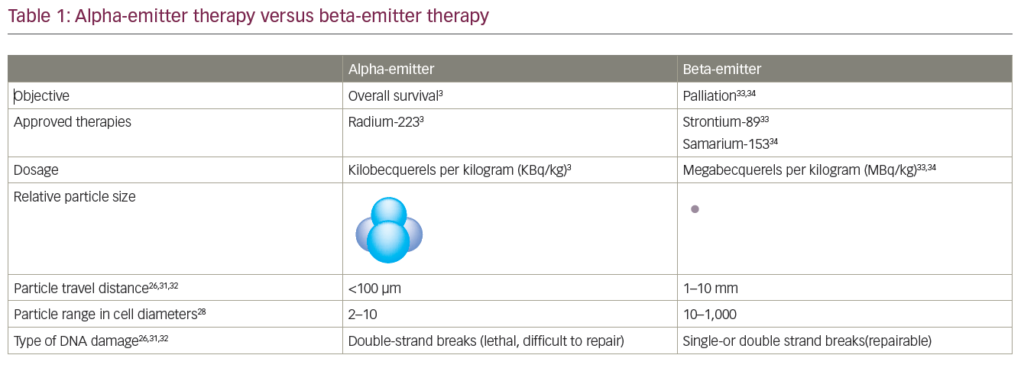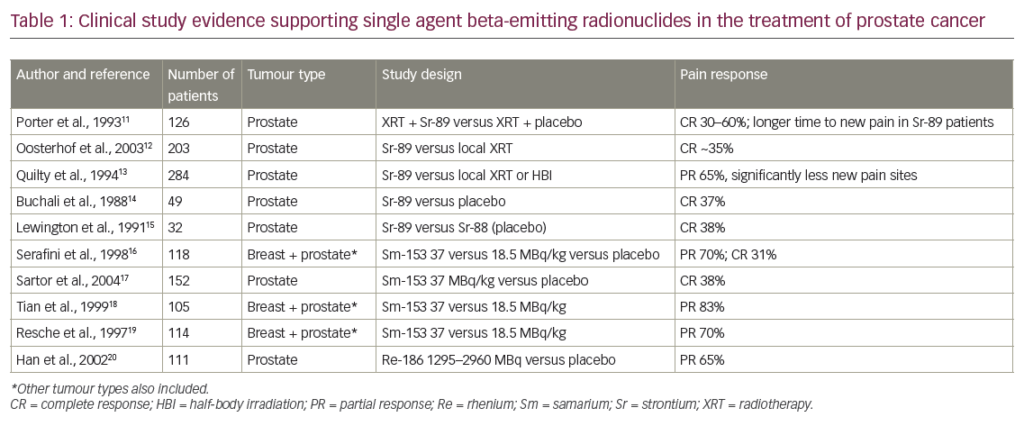Bone loss in patients with prostate cancer may be attributed to the disease itself, which is a risk factor for osteoporosis, and to ADT. Bone loss associated with ADT has been shown to increase the risk for fractures.2,3 Moreover, approximately 70% of patients with advanced prostate cancer will develop bone metastases, which cause local decreases in bone integrity. All of these disease-associated factors lead to a fragile bone state and a significant risk of skeletal complications, including pathological fractures, debilitating bone pain, and spinal cord compression. The patient’s quality of life (QoL) is affected by these complications. Therefore, symptom control and maintaining QoL are priorities for patients with hormone-refractory prostate cancer (HRPC).4,5
Treatment of Hormone-refractory Prostate Cancer
Treatment options for patients with metastatic HRPC include second-line hormonal manipulations, chemotherapy, bisphosphonates, and/or radiation/radioisotope therapy to reduce skeletal morbidity. Second-line hormonal manipulation may sometimes temporarily lower PSA levels, but these regimens have not been shown to improve survival. It is now the standard of care to stop antiandrogens when patients progress onto hormone therapy. Whether there is any clinical benefit to changing antiandrogens or increasing the dose of a given antiandrogen remains unknown.
Chemotherapy
In 1996, chemotherapy (mitoxantrone plus prednisone) demonstrated significant palliative benefits in HRPC, significantly reducing pain (p<0.0001) and improving QoL compared with prednisone alone.6 However, overall survival was not improved. This treatment regimen was subsequently approved for HRPC based on palliative benefit. Subsequently, in 2004, docetaxel plus estramustine was compared with mitoxantrone plus prednisone every three weeks, and this trial demonstrated the first survival benefit in this patient population.7 Median survival was increased by two months (p=0.01) in patients treated with docetaxel plus estramustine. A significant increase in PSA response (p<0.0001) was also observed in the docetaxel plus estramustine group. There was, however, significant added toxicity due to estramustine. A similar international trial comparing two different schedules of docetaxel (either every three weeks or weekly) plus prednisone versus mitoxantrone plus prednisone for 30 weeks demonstrated a significant 2.5-month survival advantage (p=0.009) in patients treated with docetaxel (every three weeks) compared with the mitoxantrone plus prednisone group.8 In contrast, docetaxel plus prednisone administered weekly did not demonstrate a significant improvement in survival. Docetaxel plus prednisone also significantly improved pain response and PSA response rates compared with mitoxantrone plus prednisone (p=0.01 and p=0.0005, respectively). In general, docetaxel was well tolerated. Grade 3/4 toxicities included neutropenia, with 3% of the patients in the docetaxel (every three weeks) group being hospitalized with febrile neutropenia compared with 2% of the patients in the mitoxantrone plus prednisone group. Common non-hematological adverse events included alopecia, fatigue, and nausea. By significantly improving survival and reducing both PSA and pain levels, docetaxel has now become the firstchoice chemotherapy in HRPC.Bone-targeted Therapy
Radiation/radioisotope therapy and bisphosphonates are palliative treatments for patients with bone metastases. Bisphosphonates are inhibitors of osteoclast-mediated bone resorption. They can prevent bone loss in patients with prostate cancer receiving ADT, and zoledronic acid can increase bone mineral density in this setting.9,10 Zoledronic acid has demonstrated significant clinical benefits, including the delay and prevention of skeletal complications and durable pain palliation in patients with bone metastases from HRPC.11 Moreover, bisphosphonates can be combined with chemotherapy. Indeed, zoledronic acid has been used safely with a variety of cytotoxic chemotherapies in clinical trials. Adverse events reported during bisphosphonate treatment did not appear to increase with concomitant chemotherapy.
Based on the available evidence, several guidelines, including those of the National Comprehensive Cancer Network, the European Association of Urology, and the International Consultation on Urological Diseases, recommend that bisphosphonates be used to preserve bone health and to prevent skeletal complications in patients with bone metastases from HRPC, whether asymptomatic or symptomatic.12 Presently, zoledronic acid is the only bisphosphonate that has shown efficacy in prostate cancer.
The combination of docetaxel and zoledronic acid has demonstrated additive antitumor activity in a human prostate cancer cell line, PC-3.13 The antitumor activity of docetaxel was increased with the addition of zoledronic acid in a dose-dependent manner. These results suggest that combination therapy with docetaxel and zoledronic acid could be especially active in patients with HRPC.14
Future TherapiesNovel agents are also being investigated in this setting. Several treatment modalities, such as the endothelin receptor antagonist atrasentan, have shown activity in bone metastatic HRPC in a placebo-controlled phase III trial. Although the study did not achieve its primary end-point, in patients with bone metastases there was a significant delay in progression in patients receiving atrasentan. Results from an ongoing phase III study in preventing metastases will further help in defining the role of this agent in clinical practice. Vaccines, vitamin D analogs, and antisense oligonucleotides are currently under investigation in the HRPC setting, but appear to show promising results in phase II studies. Second-line therapy after primary chemotherapy for HRPC is an active area of research. In patients who respond to first-line docetaxel, it is reasonable to rechallenge with the same agent. Other agents are presently being investigated in this setting and, to date, satraplatin appears to show activity. Antisense clusterin is presently being studied in the second-line setting in combination with chemotherapy, given the promising preclinical proof of principle.
Conclusion
Advanced HRPC is a multifaceted problem and needs a multidisciplinary approach. Urologists should remain involved from the time of diagnosis throughout the continuum of care and should be familiar with the new challenges that this disease presents. Medical oncologists will have to take up the challenge of being actively involved in decision-making earlier than they have been used to. All specialties involved need to be aware that hormone therapy diminishes bone health, chemotherapy with docetaxel can provide a survival benefit in HRPC, and zoledronic acid reduces and delays skeletal complications. Building on these positive results is necessary to further improve survival, symptom management, and QoL in these poor-prognosis patients.













